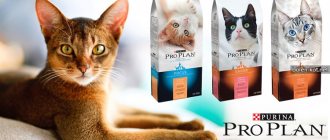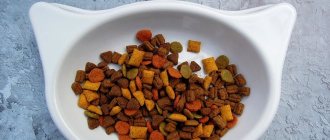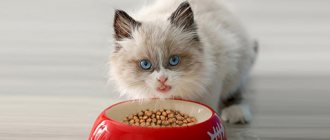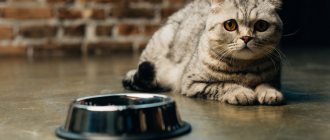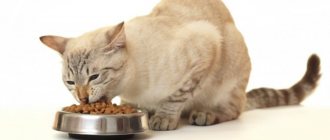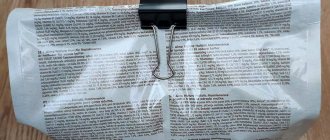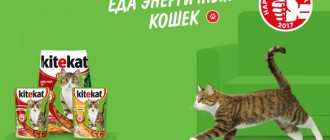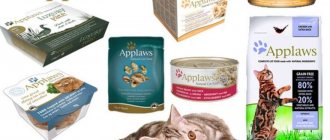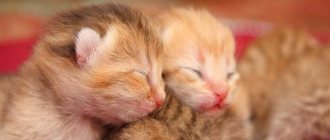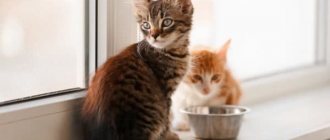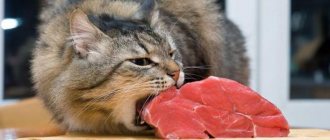The health of cats, like any pet, depends entirely on the care of the owner and his knowledge regarding the rules of keeping and feeding habits of the pet. By studying specialized literature and using the recommendations of veterinarians, you can choose the right optimal diet and understand how to feed your cat.
The importance of proper nutrition
It happens that owners realize the importance of proper nutrition for their pet only when its health begins to deteriorate. In such cases, it is necessary to urgently change her diet, even if it is a little late.
Especially if this happens during a period of intensive growth and development of the cat’s body. A caring and loving owner should know what and how much to feed a cat as soon as he decides to take it into his home.
A properly selected diet and nutrition regimen, organized for a pet from an early age, ensures the animal a long and healthy existence.
Eating improperly leads to problems in the functioning of many organs and systems. The most common complications occur with the following organs:
- Kidneys;
- Gastrointestinal tract;
- Teeth;
- Joints.
Urolithiasis and allergies may also develop.
How much does a cat need to eat? — General Considerations
If you're still wondering how much a cat should eat, here's what you need to consider:
- It is recommended to always leave cat food at their disposal because they can ration it themselves and only eat it when they are hungry and not for pure pleasure. If you don't do this, your cat will likely become anxious while waiting for food to arrive and may become stressed (with associated consequences).
- Cats are creatures of habit, so it is advisable for them to have a set daily routine as soon as they become adults.
- Following the routine task is to feed them every day in the same place and at the same time, in a quiet place and always away from their litter box.
- To feed your cat, use a mat or easy-to-clean surface on which you place a metal or ceramic bowl. Some cats prefer to eat in a flat feeder, and this helps them avoid eating too quickly.
- If you have more than one cat, you should make sure that each of them has an appropriate feeder at a considerable distance to prevent them from fighting or eating each other's food.
- Remember to keep an eye out for banned cat foods to avoid health problems.
Article by: Josie F. Turner Journalist specializing in animal welfare.
Feeding frequency
Proper nutrition includes not only balanced food, but also optimal feeding frequency. The pet’s mood and the health of its body depend on the daily norm. Feeding at regular times reduces the risk of obesity and normalizes digestion.
In addition, with a strict food intake regime, you can assess the cat’s appetite and then make adjustments to the amount of food consumed. In addition, dispensing feed at the scheduled time will prevent food spoilage, especially in hot weather.
How many times a day should you feed your cat?
- At the age of 2 to 3 months - 4-5 times (180-200 g);
- From 4 to 5 months - 3-4 times (240 g);
- From six months - 3 times (240 g);
- Adults - 2 times (200–250 g).
Nutrition for cats during special periods of life
The measured life of domestic cats changes greatly in some periods.
Illnesses and injuries, pregnancy, surgery, old age - all such changes in health require adjustments to the usual diet.
For example, nursing cats need more high-calorie food because their energy needs increase significantly. During the period of feeding kittens with milk, the volume of the daily diet should be increased, its nutritional value should be higher.
After sterilization or castration surgery, metabolism slows down in male cats. Therefore, their energy needs are reduced by approximately 25%. Appetite, on the contrary, may increase due to the lack of stress and dulling of the reproductive instinct. The owner should take these features into account in the postoperative period.
When preparing a diet for an animal after sterilization, you should give preference to low-calorie food. You can also feed a sterilized or neutered cat twice a day.
One should take into account the fact that after such an operation the frequency of urination decreases and the risk of developing urolithiasis increases. To avoid this, it is better to feed castrates with specialized food. Conventional food contains a lot of salt. This threatens the formation of kidney stones.
A sick cat usually needs a special diet, which is prescribed by a veterinarian. In especially severe cases, the animal has to be force-fed. After recovery and restoration of appetite, they return to their previous diet.
Elderly and aging cats' teeth deteriorate and other oral problems arise. Reviewing the cat's diet in this case is also very important. For example, replace dry food with canned food or introduce liquid natural dishes into the menu. You can leave only one feeding during the day. The optimal solution would be to reduce portions and increase the number of feedings. The diet of older animals should contain up to 10% carbohydrates.
Ready food
At the moment, there are many different ready-made foods; most owners choose this particular feeding option.
- Since not everyone has time to prepare healthy food from natural products.
- In ready-made food, all ingredients are balanced and provide everything necessary for the pet’s body.
What determines a cat's appetite?
Cats are very capricious animals that will never do anything they don’t want to do. This also applies to feeding regimen. A cat may refuse food offered to it for various reasons, for example, because of resentment towards the owner, due to the weather conditions, or even if it does not like the food.
Often, the answer to the question of how often and what to feed a cat depends on factors that directly affect the animal’s appetite. These include:
- The health status of the animal. If the cat is not feeling well, it will refuse food. This condition may be accompanied by other signs of the disease, such as lethargy, apathy, and lack of activity. The only way out for the owner in this case is to immediately consult a doctor to determine the cause of loss of appetite.
- The cat does not like the food offered to it. This applies not only to natural food, but also to ready-made food, which the animal eats very poorly or does not eat at all. In this case, you will have to reconsider the animal’s diet and replace its components. Often, replacing food leads to an improvement in the animal's appetite.
- A pet's appetite also depends on its age. At an early age, kittens eat more often than at a more mature age. From one year to 7 years, a cat will only need 2 meals a day; after 7 years, the frequency of feedings is reduced to 1 meal.
- Activity. Each representative of the cat family is capricious in its own way and is distinguished by activity that changes throughout life. This indicator affects calorie consumption and, as a result, appetite. You should not force a mature furry couch potato to eat the amount of food designed for a young active cat.
- A cat's appetite may also depend on gender. It is believed that the need for micronutrients in cats is significantly higher, so the appetite of males is more pronounced than that of females.
- Breed. In terms of breed characteristics, you should also pay attention to the differences in temperaments. Some breeds of cats, especially large ones, have an increased appetite.
In addition to all the reasons listed, the cat’s feeding regimen may depend on its condition. A pregnant female can consume up to 3 times more food than before.
Balinese cat
Dry food
Ready-made foods produced by different companies have different nutritional properties. Most often, the packaging indicates the weight and age of the pet for which the food is intended, as well as the recommended amount of the product.
Dry food mainly consists of a mixture that includes:
- Meat products;
- Cereals;
- Plant products.
All this is dried using a special method. This food is very convenient because you can safely leave it in a bowl if the cat is left at home alone for a long time. There is no way to visually determine the composition of the granules. Therefore, when choosing a brand of food, you need to know the product category and give preference to premium and super-premium.
What a kitten is forbidden to eat - list
Many of us are unable to resist the pleading expression of such unhappy and such hungry eyes of our little pet, even if he ate a hearty meal five minutes ago and simply wants more. Of course, convincing your baby not to feed him from your plate is almost useless: anyway, the little sly one will manage to lure a tasty morsel out of you from time to time. But there are foods that are strictly prohibited to be given to a kitten. You should know about them.
The list of foods prohibited for kittens includes:
- pork (both boiled and raw);
- sausages, small sausages and sausages containing amounts of spices and salt that are unacceptable for kittens;
- fatty dairy products - cheeses, butter, whole milk, country sour cream and cream;
- raw freshwater fish – kittens should not be given fish at all, including sea fish;
- potatoes and beans - the kitten’s stomach does not cope well with such foods;
- corn and wheat cereals - this includes semolina porridge, beloved by many cat owners;
- sweets, pastries and chocolate – many kittens enjoy eating chocolates, but this should not be allowed;
- and, of course, no fast food.
In addition, veterinarians strongly advise against purchasing economy-class food. They are practically useless not only for babies, but also for adult animals. This is practically the same as fast food for us - nothing but a load on the kidneys and liver.
Wet food
They can be in the form of pouch bags and canned food with pate or stew.
- Pouches are sold in bags of 85 and 100 g.
- The food in them consists of pieces of meat in sauce, with the addition of cereals and plant products.
In addition to vegetables, fish and meat, the products contain added vitamins and minerals. Therefore, this food is a complete nutrition of proper quality.
How much does a kitten weigh?
Gradual and sufficient weight gain is the main indicator of proper development. If you know the age and breed of the kitten, just weigh it on the scale.
It is advisable to weigh kittens weighing up to 1 kg on electronic kitchen scales that have a small error. To do this, use either a special container that comes with the scales, or a suitable plastic container.
Larger pets can also be weighed on household floor scales. As a last resort, you can weigh yourself, and then with your pet in your arms - and calculate the difference.
It is believed that until the age of six months, a kitten gains, on average, 100 grams of weight per week. After 6 months, the growth of a kitten of most breeds almost stops, but the weight continues to increase due to an increase in muscle mass.
However, there are breed characteristics - for example, Maine Coons grow very slowly and only by two years, or even later, gain their final weight and height. So for more accurate information, it is better to contact the breeder or a specialized website for the breed.
Here is a table showing the approximate weight parameters of kittens of different breeds by month. You can focus on it when determining the norm of development of a kitten.
Kitten weight table
| Development of kittens in the first year of life | ||||||
| Age | Weight of cats, g | Cats weight, g | ||||
| average | big | very large | average | big | very large | |
| 4 weeks | 550 | 630 | 820 | 450 | 560 | 740 |
| 6-8 weeks | 1000 | 1230 | 1500 | 900 | 1150 | 1400 |
| 10-12 weeks | 1350 | 1800 | 2300 | 1200 | 1700 | 2300 |
| 14-16 weeks | 1700 | 2700 | 3800 | 1500 | 2600 | 3600 |
| 5 months | 2050 | 3200 | 5500 | 1800 | 2900 | 4300 |
| 6 months | 2400 | 3900 | 6000 | 2100 | 3200 | 4500 |
| 7 months | 2750 | 4200 | 6500 | 2400 | 3500 | 4900 |
| 8 months | 3100 | 4500 | 6900 | 2700 | 3800 | 5200 |
| 9 months | 3450 | 5000 | 7000 | 3000 | 4100 | 5500 |
| 10 months | 3800 | 5200 | 7700 | 3200 | 4200 | 5800 |
| 11 months | 4050 | 2600 | 8000 | 3350 | 4300 | 6100 |
| 12 months | 4500 | 5700 | 9000 | 3500 | 4500 | 6800 |
| 18 months | 6000 | 9500 | 4700 | 7000 | ||
Daily norm
Conscientious food manufacturers indicate on the packaging information about the recommended daily intake, which depends on the weight and age of the pet.
It is worth noting that if the norm is small, then the product is saturated with nutrients. The average volume of wet food is 5% of the pet’s weight.
Approximately how many times per day to feed an adult cat with ready-made food based on the weight of the animal:
- Up to 3kg - 25g;
- From 3 to 4 kg - 40g;
- From 4 to 5 kg - 55–65 g;
- From 5kg - 12g per 1kg of weight.
Kittens that weigh less than two kilograms per day need 35 grams of food, and those weighing from 2 to 3 kg need 50 grams of food.
For pregnant and lactating cats, the amount of food should be doubled. That is, if a female weighs 4-5 kg, then she will need 100–130 g per day.
When switching your pet to another type of food, you need to gradually mix a new one into the usual food, each time increasing the volume of the new food.
How to tell if your pet has enough food
The daily food intake recommended by experts for pets of different ages may not always be suitable for each individual animal. You can determine whether your cat's daily amount of food is sufficient by observing her for some time. If a pet is malnourished, it constantly searches for food, loses weight, and its fur becomes dull and falls out. In this case, the amount of food can be increased slightly. As a rule, healthy, balanced animals do not overeat. Neutered cats can be prone to gluttony.
To control your pet's weight, you need to practice regular weighing. A three-month-old kitten should weigh approximately 1700–2300 grams, a four-month-old kitten should weigh from 2500 to 3500 grams, and a five-month-old kitten should weigh 3–4 kilograms. Females usually weigh less than males, and the norm of the animal’s weight also depends on the breed. For example, a male "British" at the age of 12 months should weigh from 4.5 to 7 kg, and a female - 2.5-4.7 kg. The weight of a Maine Coon cat at the same age should range from 5.9 to 9 kg, and of cats - from 4.5 to 7.5 kg.
You can determine how well-fed an animal is without weighing. To do this you need to palpate his body. If the ribs cannot be felt, then most likely the pet’s weight exceeds the norm.
Natural diet
It is not easy to create a complete diet from natural products; this requires following some rules and being patient.
- Cats are naturally conservative, so they do not require a varied diet.
- Once you set the correct diet, you can use it constantly.
It is worth considering that to maintain and preserve the health of the animal, free access to water is very important, which needs to be changed twice a day.
Constant access to food: yes or no
It is not a good idea to provide your cat with constant access to food. Thus, the owner himself can provoke the animal to have an extra snack. Overeating leads to weight gain, which is a direct path to obesity. The latter is dangerous for the development of heart disease, oncology, diabetes, and digestive tract diseases.
The cat may not overeat, but why take the risk?
The exception is when providing access to food is necessary. For example, if a cat eats poorly due to illness and needs to eat as often as possible.
Water in the diet
Water should be present in the bowl at all times, and it should be clean, especially if the pet eats dry food.
- With a natural diet, the cat requires less fluid, but still needs it.
- You can determine whether your pet has enough fluid by looking at its fur and the frequency of urination.
If the coat is silky and shiny, and its owner is active and empties at least twice a day, then this means that the diet contains enough fluid.
How to feed a newborn kitten without a cat
Anything can happen in life. The cat may die during childbirth or abandon the babies. You can pick up a newborn kitten on the street or they will simply throw it at you. If there is no suitable nurse nearby, you will have to take care of the nutrition of the motherless kittens yourself.
Kittens age from 0 to 10 days
For the first ten days of a kitten’s life, it is fed a special formula that can be purchased at a veterinary store. Preferably from a bottle to develop the sucking reflex. But if you don’t have a bottle, an ordinary pipette will do.
For the first three days, newborn babies are fed every two hours (including at night). On the fourth day, they begin to give food less often - once every four hours.
You may be interested in: Everything about feeding a newborn kitten
During the first two weeks, kittens are given thirty to forty milliliters of mixture per hundred grams of weight and some warm water per day. You cannot feed a kitten with whole cow's milk! This is too much stress for his tiny stomach.
Kittens age from 10 to 30 days
From ten days of age to one month, babies can be fed with self-prepared milk formula. This is especially true when it is not possible to often go to the pet store. When preparing the mixture, strictly follow the indicated proportions so as not to provoke an upset stomach in the kitten.
Formula proportions:
- cow's milk (homemade if possible) – 100 milliliters
- powdered milk – 30 grams;
- chicken yolk – 1 piece;
- grape sugar – 8 grams;
- dry yeast - 5 grams.
If you do not have the opportunity to prepare a special formula, use a regular baby formula or feed your babies diluted goat milk. By one month, the baby should receive from 50 to 55 milliliters of mixture per day. Starting from three weeks of age, the kitten can be gradually introduced to adult food.
The kitten is from one month to two months old
By one month, your little pet becomes completely independent and can eat from a bowl, although some babies still ask for a bottle. The size of the daily diet continues to increase little by little and by two months it should reach two hundred grams.
What can you feed your baby?
- Fresh chicken broth;
- vegetable puree;
- low-fat pureed cottage cheese;
- boiled yolks (quail or chicken);
- low-fat milk or formula;
- boiled lean meat and boiled fish (chopped and boneless).
All food for kittens of this age should be ground in a meat grinder (twice) or using a blender.
The kitten is two to three months old
Starting from two months, the kitten is fed four times a day. By three months, he should eat up to three hundred grams of food per day.
The diet of a kitten of this age should consist of:
- lean veal and beef;
- boiled chicken meat;
- boiled white fish;
- soft boiled porridges;
- raw and baked vegetables – always chopped;
- low-fat cottage cheese;
- fermented milk products with a low fat content;
- raw chicken or quail yolk.
Age - three months
Starting from three months, the kitten is gradually accustomed to solid food. By this time, babies are fed three times a day, increasing the daily nutritional intake to three hundred and sixty grams.
At three months of age, the kitten’s usual diet is replenished with:
- raw meat and fish;
- milk porridges.
Kitten age 3-4 months and older
By four months, three quarters of a kitten’s daily diet should consist of raw and boiled meat and fish (without bones, of course). From this age he switches to adult food. If you gave your kitten exclusively natural products until four months old, you can gradually introduce him to specialized high-class food. They are easier to use and much more useful. You will not need to specifically buy vitamin complexes for your pet. They are already contained in the best feeds.
Example of an optimal menu
If you are short on time, you can prepare mixtures that are sufficiently nutritious and balanced in advance and freeze them. There are recipes approved by experts, of which the most simple ones can be distinguished.
From meat, buckwheat or rice and vegetables:
- Beef - 2kg;
- Vegetables - 500 g (they are boiled separately).
- Cereals - 200g;
Grind everything in a meat grinder and freeze in portions.
From chicken fillet:
- Chicken fillet - 1 kg;
- Vegetables - 150g.
- Boiled rice - 100g;
Pass everything through a meat grinder, form into balls and boil. After the meatballs have cooled, they need to be frozen.
In addition to main dishes, a cat’s daily diet should include about 30 grams of fermented milk products.
The choice of type of feeding for a pet depends on the owner, his capabilities and preferences. Each food has its own advantages and disadvantages. A caring owner will, if desired, find the best option for his pet.
Industrial feed: pros and cons
Industrial animal feeds are divided into two types:
- wet food - canned food in the form of pates, pieces of meat with sauce;
- dry granulated food - small crackers.
Feeding natural food will require a lot of knowledge, patience and time. With skillful preparation of a correct and balanced menu, such nutrition will be healthier and safer.
Ready-made food has its advantages and disadvantages compared to natural food.
Industrial feed is better for several reasons:
- contains a complete balance of essential vitamins and microelements;
- easy to calculate and control the size and number of servings;
- long shelf life;
- feeding with dry food is more convenient;
- the opportunity to choose specialized veterinary food that meets the needs of a cat with health conditions.
Cats that eat only dry food must always have fresh water available.
Disadvantages of using industrial feed:
- high cost of quality feed;
- In canned food with sauce, more than half of the volume is water. Satiety with such food is reduced;
- high salt content, which threatens the development of urolithiasis;
- This food is addictive. It becomes very difficult to switch a cat to a different diet.
When feeding with ready-made store-bought food, you should pay attention to the mark indicating whether any type of food is complete. It can only serve as an additive to the main diet and does not satisfy all the nutritional needs of the cat.
When combining dry food with canned food, it is better to stick to the proportion - about 70% dry food and 30% canned food.
Some artificially bred cat breeds are susceptible to allergies and metabolic disorders. To maintain health, it is recommended to feed them only with fully balanced ready-made special food.
Photo of the best cat food
Is there enough food for the cat?
It's also important to weigh your cat periodically to make sure he hasn't gained extra pounds or lost a lot of weight, both of which can negatively impact his health. For most domestic cats, the standard weight is 2-4.5 kg, so if the pet’s weight exceeds these limits, you need to change your approach to feeding. It could be:
- changing the type of food;
- increasing/decreasing the number of meals.
You can also tell if your pet is getting enough food by looking at its ribs:
- if the ribs protrude too much, this is a sign of malnutrition and excessive thinness;
- if the ribs cannot be felt, this is a sign of obesity.
Normally, a cat's ribs should be covered with a small layer of fat and not “shine through” the skin, but they can be easily felt. For pregnant animals, an increase in the amount of fat on the sides is quite acceptable.
Each animal’s body is unique, so it is important not to blindly follow the recommendations, but to select a feeding regimen for your pet taking into account its individual characteristics.
